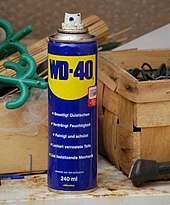WD-40
WD-40 is the trademark name of a water-displacing spray manufactured by the WD-40 Company based in San Diego, California.[1]
 | |
WD-40 with Smart Straw | |
| Product type | water displacer |
|---|---|
| Owner | WD-40 Company |
| Country | San Diego, California, United States |
| Introduced | September 23, 1953 |
| Website | www |

History
Different sources credit different men with inventing WD-40 formula in 1953 as part of the Rocket Chemical Company (later renamed to WD-40 Company), in San Diego, California; the formula was kept as a trade secret and was never patented.[2]
According to Iris Engstrand, a historian of San Diego and California history at the University of San Diego, Iver Norman Lawson invented the formula,[3] while the WD-40 company website and other books and newspapers credit Norman Larsen. According to Engstrand, "Lawson was acknowledged at the time, but his name later became confused with company president Norman B. Larsen."[4][5][2] "WD-40" is abbreviated from the term "Water Displacement, 40th formula", suggesting it was the result of the 40th attempt to create the product.[1] The spray, composed of various hydrocarbons, was originally designed to be used by Convair to protect the outer skin of the Atlas missile from rust and corrosion.[6][7] This outer skin also functioned as the outer wall of the missile's paper-thin fuel balloon tanks, which were so fragile that, when empty, they had to be kept inflated with nitrogen to prevent them from collapsing. WD-40 was later found to have many household uses[1] and was made available to consumers in San Diego in 1958.[6]
In Engstrand's account, it was Iver Norman Lawson who came up with the water-displacing mixture after working at home, and turned it over to the Rocket Chemical Company for the sum of $500 (equivalent to $4,800 in 2019). It was Norman Larsen, president of the company, who had the idea of packaging it in aerosol cans and marketed it in this way.[3]
It was written up as a new consumer product in 1961.[8] By 1965 it was being used by airlines including Delta and United; United, for example, was using it on fixed and movable joints of their DC-8 and Boeing 720s in maintenance and overhaul.[9] At that time, airlines were using a variant called WD-60 to clean turbines, removing light rust from control lines, and when handling or storing metal parts.[9] By 1969 WD-40 was being marketed to farmers and mechanics in England.[10] In 1973, WD-40 Company, Inc., went public with its first stock offering. Its NASDAQ stock symbol is (NASDAQ: WDFC).[11]
In 2014, WD-40 was inducted into the International Air & Space Hall of Fame at the San Diego Air & Space Museum.[12]
By the fiscal year 2017, gross revenue for the company, including sales of the familiar WD-40 Multi-Use as well as other products, totaled $381 million in annual revenue; about half of this was for sales outside the US. CEO Garry O. Ridge told a NASDAQ publication that they manufacture the "secret formula" in four plants located in various countries and ship it to other companies which then blend and package the product before shipping it to customers.[13]
Formulation
WD-40's formula is a trade secret, and has not changed over the years, according to historian Iris Engstrand.[3]
To avoid disclosing its composition, the product was not patented in 1953, and the window of opportunity for patenting it has long since closed.[7]
WD-40's main ingredients as supplied in aerosol cans, according to the US Material Safety Data Sheet information,[14] and with the CAS numbers interpreted:[15]
- 45-50 % low vapor pressure aliphatic hydrocarbon (isoparaffin)
- <35% petroleum base oil (non hazardous heavy paraffins)
- <25% aliphatic hydrocarbons (same CAS number as the first item, but flammable)
- 2-3% carbon dioxide (propellant)
The UK (and EU) formulation is stated[16] according to the REACH regulations:
- 60-80% hydrocarbons C9-C11 n-alkanes, iso-alkanes, cyclics <2% aromatics
- 1-5% carbon dioxide
The Australian formulation is stated [17] as
- 50-60% Naphtha (Petroleum), hydrotreated heavy
- <25% Petroleum Base Oils
- <10% Naphtha (petroleum), hydrodesulfurized heavy (contains: 1,2,4-Trimethyl benzene, 1,3,5-Trimethyl benzene, Xylene, Mixed Isomers)
- 2-4% Carbon Dioxide
In 2009, Wired published an article with the results of gas chromatography and mass spectrometry tests on WD-40, showing that the principal components were C9 to C14 alkanes and mineral oil.[18]
References
- "Q&A WD-40 CEO Garry Ridge explains company's slick success". latimes.com. July 30, 2015. Retrieved July 30, 2015.
- Martin, Douglas (July 22, 2009). "Obituary: John Barry, Popularizer of WD-40, Dies at 84". The New York Times.
- Engstrand, Iris H.W. (Fall 2014). "WD-40: San Diego's Marketing Miracle" (PDF). The Journal of San Diego History. 60 (4): 253–270.
- "WD-40 History – History and Timeline". WD-40 Company. Retrieved April 10, 2017.
- Bobby Mercer (2011). ManVentions: From Cruise Control to Cordless Drills – Inventions Men Can't Live Without. Adams Media. pp. 181–. ISBN 978-1-4405-1075-5. Retrieved June 28, 2013.
- "Our History". WD-40.
- Martin, Douglas (July 22, 2009). "John S. Barry, Main Force Behind WD-40, Dies at 84". The New York Times.
- Changing Times (pre-1986) 15.5 (May 1, 1961): p. 36.
- "New Materials". Aircraft Engineering and Aerospace Technology. 37 (5): 165. May 1965. doi:10.1108/eb034021.
- "New on the Market". Farm & Country. London. January 1969. p. 72.
- "History". WD-40. January 2017.
- Sprekelmeyer, Linda, editor (2006).These We Honor: The International Aerospace Hall of Fame. Donning Co. Publishers, ISBN 978-1-57864-397-4.
- NASDAQ Marketinsite January 18, 2018
- "SDSUSA" (PDF). www.wd40.com. March 5, 2019. Retrieved February 17, 2020.
- "ChemIDplus". chem.nlm.nih.gov. Retrieved February 17, 2020.
- "WD-40® Multi-Use Product". wd40.co.uk. March 7, 2017. Retrieved February 17, 2020.
- "WD-40® Multi-Use Product" (PDF). wd40.com.au. July 5, 2018. Retrieved August 7, 2020.
- Di Justo, Patrick (April 20, 2009). "What's Inside WD-40? Superlube's Secret Sauce". Wired. Archived from the original on January 19, 2014. Retrieved April 24, 2014.
External links
| Wikimedia Commons has media related to WD-40. |